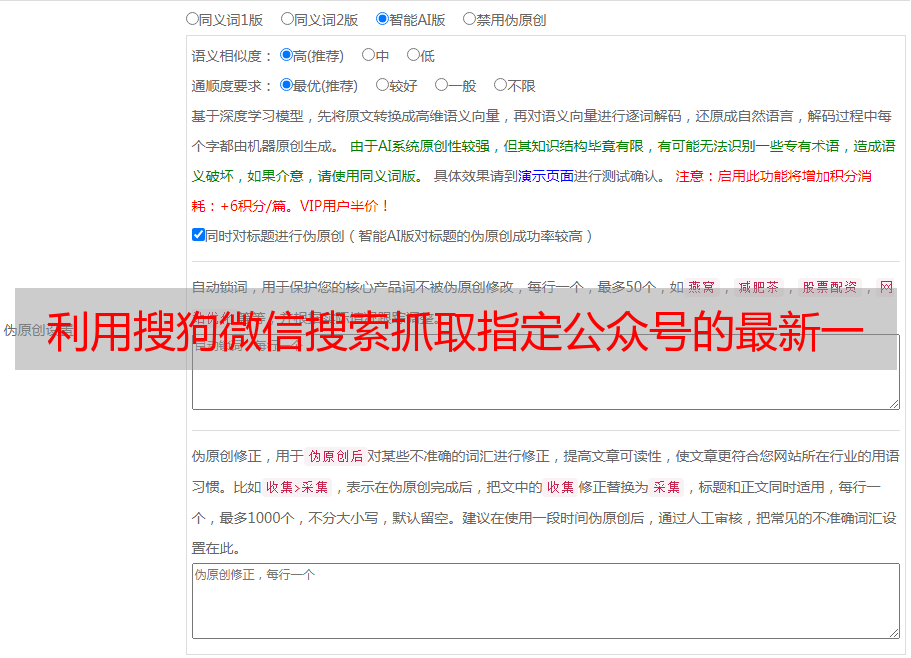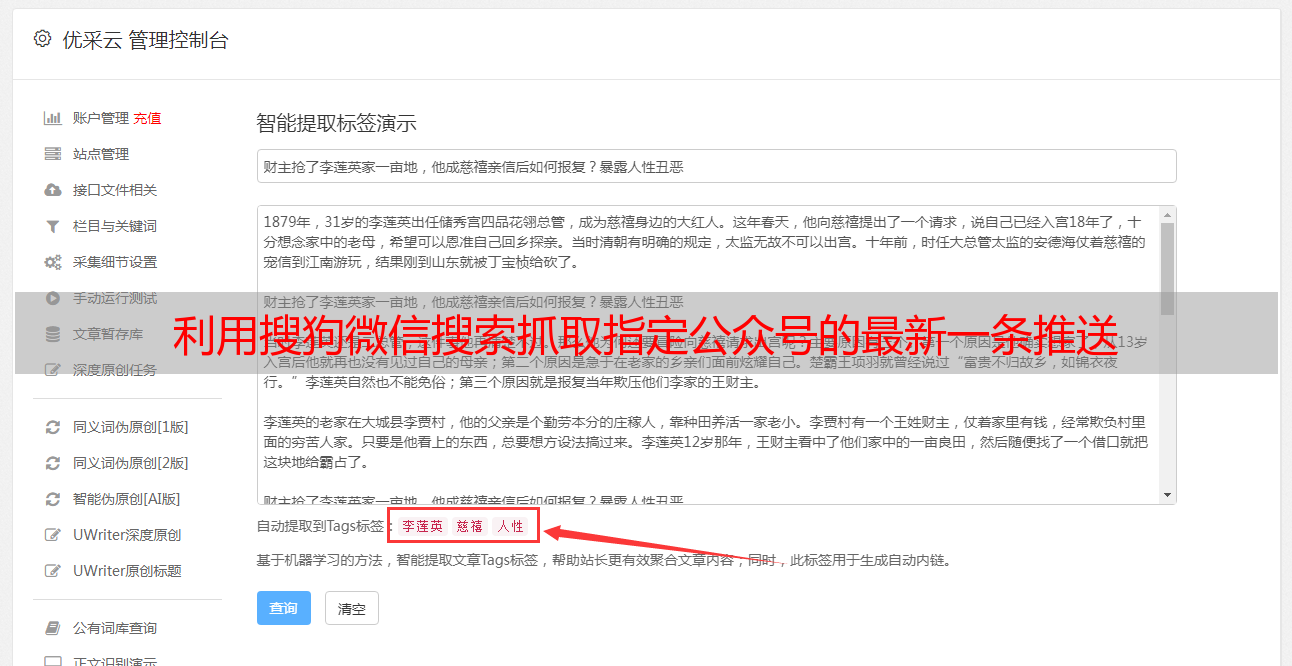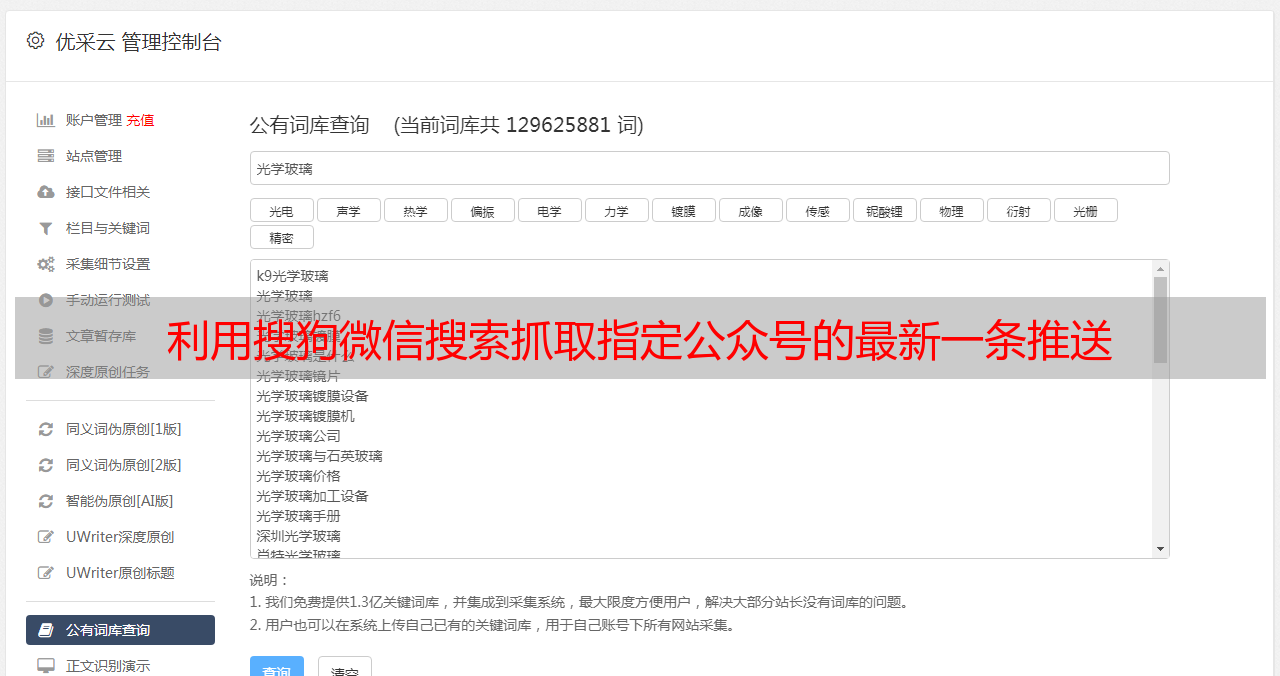利用搜狗微信搜索抓取指定公众号的最新一条推送
优采云 发布时间: 2021-07-17 23:10利用搜狗微信搜索抓取指定公众号的最新一条推送
问题描述
使用搜狗微信搜索抓取指定公众号的最新推送,并将相应网页保存到本地。
注意搜狗微信获取的地址为临时链接,具有时效性。公众号为动态网页(由JavaScript渲染),使用requests.get()获取的内容不收录推送消息。这里使用selenium+PhantomJS来处理代码
#! /usr/bin/env python3
from selenium import webdriver
from datetime import datetime
import bs4, requests
import os, time, sys
# 获取公众号链接
def getAccountURL(searchURL):
res = requests.get(searchURL)
res.raise_for_status()
soup = bs4.BeautifulSoup(res.text, "lxml")
# 选择第一个链接
account = soup.select('a[uigs="account_name_0"]')
return account[0]['href']
# 获取首篇文章的链接,如果有验证码返回None
def getArticleURL(accountURL):
browser = webdriver.PhantomJS("/Users/chasechoi/Downloads/phantomjs-2.1.1-macosx/bin/phantomjs")
# 进入公众号
browser.get(accountURL)
# 获取网页信息
html = browser.page_source
accountSoup = bs4.BeautifulSoup(html, "lxml")
time.sleep(1)
contents = accountSoup.find_all(hrefs=True)
try:
partitialLink = contents[1]['hrefs']
firstLink = base + partitialLink
except IndexError:
firstLink = None
print('CAPTCHA!')
return firstLink
# 创建文件夹存储html网页,以时间命名
def folderCreation():
path = os.path.join(os.getcwd(), datetime.now().strftime('%Y-%m-%d_%H-%M-%S'))
try:
os.makedirs(path)
except OSError as e:
if e.errno != errno.EEXIST:
raise
print("folder not exist!")
return path
# 将html页面写入本地
def writeToFile(path, account, title):
pathToWrite = os.path.join(path, '{}_{}.html'.format(account, title))
myfile = open(pathToWrite, 'wb')
myfile.write(res.content)
myfile.close()
base ='https://mp.weixin.qq.com'
accountList = ['央视新闻', '新浪新闻','凤凰新闻','羊城晚报']
query = 'http://weixin.sogou.com/weixin?type=1&s_from=input&query='
path = folderCreation()
for index, account in enumerate(accountList):
searchURL = query + account
accountURL = getAccountURL(searchURL)
time.sleep(10)
articleURL = getArticleURL(accountURL)
if articleURL != None:
print("#{}({}/{}): {}".format(account, index+1, len(accountList), accountURL))
# 读取第一篇文章内容
res = requests.get(articleURL)
res.raise_for_status()
detailPage = bs4.BeautifulSoup(res.text, "lxml")
title = detailPage.title.text
print("标题: {}\n链接: {}\n".format(title, articleURL))
writeToFile(path, account, title)
else:
print('{} files successfully written to {}'.format(index, path))
sys.exit()
print('{} files successfully written to {}'.format(len(accountList), path))
参考输出
解析链接获取 首先进入搜狗的微信搜索页面,在地址栏中提取需要的链接部分,将字符串与公众号名连接,然后生成请求链接。对于静态网页,使用requests获取html文件,然后使用BeautifulSoup选择所需内容为动态网页。使用selenium+PhantomJS获取html文件,然后使用BeautifulSoup选择需要的内容遇到验证码(CAPTCHA),并输出提示。该版本的代码实际上并没有处理验证码,需要在运行程序之前手动访问,以避免验证码。文件写入使用os.path.join()构造存储路径,提高通用性。例如,Windows 路径分隔符使用反斜杠 (\),而 OS X 和 Linux 使用正斜杠 (/)。此功能可根据平台自动转换。 open() 使用 b(二进制模式)参数提高通用性(适用于 Windows),使用 datetime.now() 获取当前时间进行命名,并通过 strftime() 格式化时间(函数名中的 f 代表格式),具体参考下表(摘自Automate the Boring Stuff with Python)
参考链接:文件夹创建:异常处理的使用:enumerate的使用:open()使用b参数原因:





